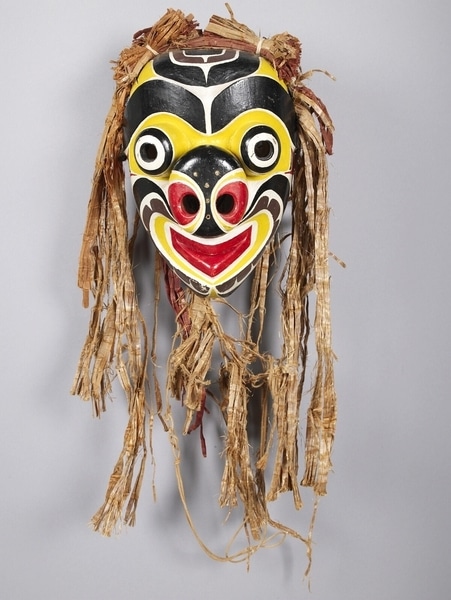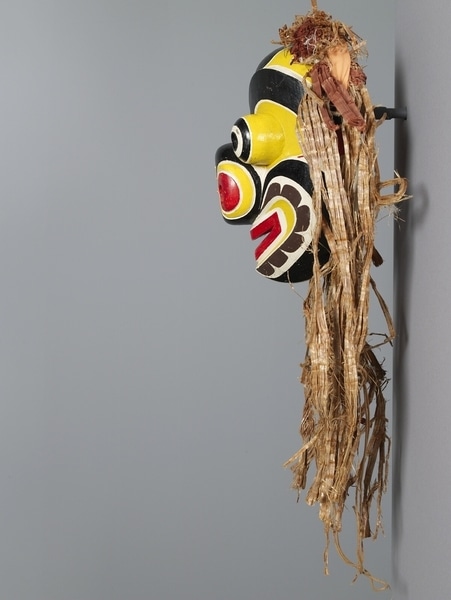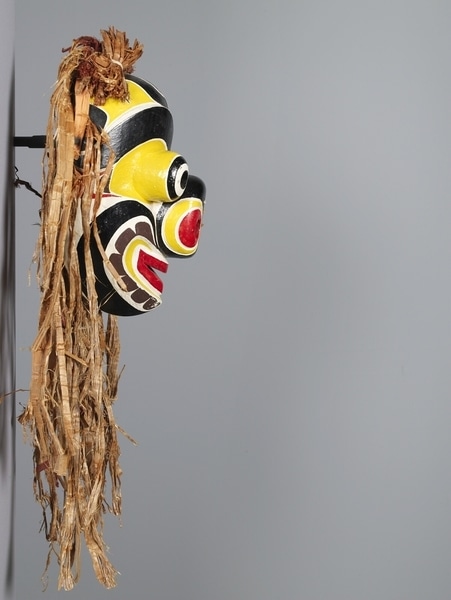Bee Mask Item Number: Nb3.1364 from the MOA: University of British Columbia




Description
Bee mask. Rounded forehead has split U forms, yellow with black splits at sides, partially covered by cedar bark, vertical series at centre has black and red- brown with white and a solid black U; curved thick black brows with ends curling towards side rims; white temples with black and red U forms; small orbital area, base of protruding circular hollow eyes and base of snout between eyes are yellow; black and white bands around top of eyes; bulbous protruding snout has black triangular design at top and bottom joined by a narrow band, cluster of five drilled holes, four with remains of 'stingers'; white, yellow and red crescentic bands around hollow circular nostrils; defining line on cheek melds with orbital ridge; white cheeks have crescentic black line varying in thickness; series of twelve U forms along mouth ridge, white and yellow lines around red lip band, rounded upper lip and pointed lower lip; yellow triangular upturned chin. Cut cedar bark, tied with white cord and folded around a folded piece of orange-pink cloth that is nailed to the upper rim; brown cord is loosely twined into cedar bark 2/3 from top rim. On reverse, a single green cord is passed through two holes at upper rim, looped and knotted through a hole at each temple; white cord binds green cord at upper rim; hole in bottom centre of chin.
History Of Use
The Hamsalał dancers flit around the floor to a rapid drum beat, “stinging” people who are later paid with special gifts (the stingers are missing from this mask). The dance is an inherited privilege passed from one generation to the next within a family.
Cultural Context
ceremonial
Narrative
This mask has been danced on several occasions: a potlatch given by B. Taylor in 1948; a dance given by B. Taylor's mother, no date; finally, a potlatch given by George Speck, Patrick Taylor's uncle, in Alert Bay, May 1986. When they were offered for sale to the Museum, their purchase price included funds for a new set of masks to be commissioned from a contemporary Kwagu’ł artist, to allow the family to continue to display the privilege in ceremony. This set of masks (Nb3.1361-64) were made during the period of potlatch prohibition (1884–1951) when their use in ceremony was still deemed illegal by federal legislation. They were commissioned by their original Ma’amtagila Kwagu’ł owner, from the artist Willie Seaweed and his son, Joe.
Item History
- Made by Willie Seaweed (Maker) in Blunden Harbour, British Columbia, Canada ? or Ba'as, British Columbia, Canada ? during 1948
- Collected in Fort Rupert, British Columbia, Canada and Tsaxis, British Columbia, Canada
- Owned by Bob Taylor
- Owned by Patrick Taylor before October 21, 1986
- Received from Museum of Anthropology Shop Volunteers (Funding source) and Patrick Taylor (Seller) on October 21, 1986
What
Who
- Culture
- Kwakwaka'wakw
- Creator
- Willie Seaweed (Maker)
- Previous Owner
- Bob Taylor and Patrick Taylor
- Received from
- Museum of Anthropology Shop Volunteers (Funding source) and Patrick Taylor (Seller)
Where
- Holding Institution
- MOA: University of British Columbia
- Made in
- Blunden Harbour, British Columbia, Canada ? or Ba'as, British Columbia, Canada ?
- Collected in
- Fort Rupert, British Columbia, Canada and Tsaxis, British Columbia, Canada
When
- Creation Date
- during 1948
- Ownership Date
- before October 21, 1986
- Acquisition Date
- on October 21, 1986
Other
- Condition
- good
- Current Location
- Case 22
- Accession Number
- 1168/0004